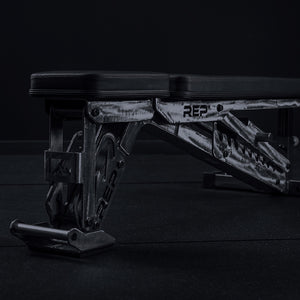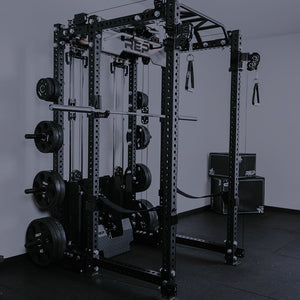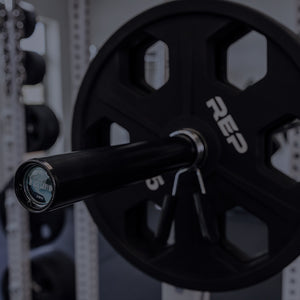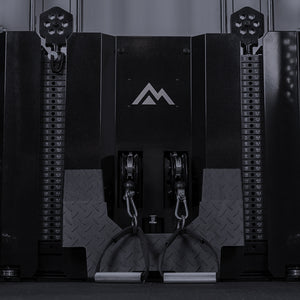
They all weigh the same, but they don’t function the same.
When selecting weight plates for your home or commercial gym, there are tons of different options – but two main umbrella categories: irons and bumpers.
What Are Iron Plates?

Iron plates are just what they sound like: the hard, iron weight plates that make clanking noises and that satisfying, sharp, sliding sound when you load them onto your barbell.
Iron plates are those classic, old-school circles. They’re usually silver or black (REP’s are all black). There are different types of iron plates, as well:
- Old School Iron Plates
- Rubber-Coated Olympic Plates (not the same as bumpers, although they are coated in rubber)
- Urethane-coated Equalizer ® plates (also not bumpers, despite the rubber-ish urethane layer)
- Equalizer® iron plates
- Basic Iron Plates (discontinued)
You can also find iron change plates and fractional plates, in both pounds and kilos. (Read more about change plates vs. fractional plates here.)
What Are Bumper Plates?

Bumpers are rubber-coated plates that can be black but are also frequently multi-colored. These typically have a steel core surrounded by a thick, high-density, rubber coating (not to be confused with the thin coating you may find on irons to protect them from scratches).
You can find a variety of fun bumpers of different colors, patterns, and styles:
- Black Bumper Plates (in pounds and kilos)
- Color Bumper Plates (in pounds and kilos)
- Pinnacle™ plates (crumb rubber featuring artistic mountain designs)
- Sport Bumper Plates (color coded)
- Animal Print Bumper Plates
- Competition Bumper Plates (in both pounds and kilos)
- Hi-Temp Bumper Plates (environmentally friendly, recycled, vulcanized rubber)
- Technique Plates (in pounds and kilos)
Benefits of Iron Plates

Don’t cast off the irons just yet (<-- elite pun). A lot of lifters prefer the clang and bang. Here are some bennies of iron plates:
They’re great for competitive powerlifters. Irons are especially popular among powerlifters, whose three lifts rarely crash against the floor from up high (er, at least if you have good control and are using your safeties).
In fact, competitive powerlifters don’t want to practice dropping the bar at all; many rulebooks state the powerlifter must lower the bar with control to the floor – and you could argue dropping or even slamming a bar against the platform isn’t full control.
Width matters. If you practice with bumpers and then head to a meet that uses calibrated plates or irons, you’ll likely feel a difference, because the different width changes the lever and bend of the bar, Hamilton says. Bumpers provide a slight advantage, which can make irons feel harder on the platform. Tighter-packed plates also means less whip.
Mmm, the sound. Seriously. It’s a love language.
Iron plates weigh more than bumpers. OK, not really. But the memes ring true among some old-school lifters who don’t believe it’s “real” lifting unless it’s clanking.
They’re more compact for storage in gyms with limited space. You can fit more irons on a plate tree or weight horns. For example, 6” weight horns can hold four 45lb bumpers totaling 180lbs or seven 45lb irons totaling 315lbs.
They have that old-school feel. Some lifters just love that gritty, classic, iron vibe. It feels good (mentally and physically) to slang iron.
You can fit more on the bar. Because bumpers are usually thicker than irons, you can load more irons onto a barbell. This really just applies to people moving heavy loads above 405lbs, or four plates per side.
Benefits of Bumper Plates

Bumper plates are typically associated with Olympic weightlifting and functional fitness (X-fit), but they are increasingly popular for home gyms and general lifestyle lifters. Here are some of the reasons people choose bumpers:
You can drop them. Bumpers are designed to be repeatedly dropped – from above the head, even – without damaging the plates, bar, your floor, equipment, or yourself. This makes them a great fit for Olympic-style lifts, when you sometimes must drop the weights from high to not injure yourself.
They are easier on the floor. This is a big selling point for home and garage gyms. Bumpers plus good gym flooring is double the protection against cracks.
They’re quieter. Due to the rubber outside, bumpers are a lot quieter than irons.
They’re great for beginners, according to Heather Hamilton, exercise physiologist and co-owner of Barpath Fitness. Because even lightweight bumpers are the same diameter as the heavier plates, you can perfect your technique at the optimal height.
They’re super durable and rust-resistant, thanks to their protective coating, even in high humidity.
They’re thicker, which (let’s just be honest here) can make a lift look more impressive. Three bumpers look like a lot more weight than three thin irons.
They’re versatile. You can use bumpers for any barbell lift, but you might not want to use irons for everything.
They’re nice for, uh, ego lifting. You can probably lift more weight with bumpers than irons. Bumpers bend the bar more, because they’re fatter -- so they are farther from the center of the bar where you stand. Need proof there’s more bend? Hold a plate close to your body, and then hold it away from your body; farther away is harder to keep your arms straight, right? Same goes for the bar. This affects how the pull feels, and it also brings the plates closer to the ground when you lockout.
They have different weight jumps. Bumpers and irons are typically available in different weight jumps, which may be a benefit – or just a difference. Bumpers usually come in 10, 15, 25, 35, 45, and 55lbs. Irons are usually 5, 10, 25, and 45lb increments. You may also find 2.5 and 35lb options – but don’t be looking for a 15lb iron. And a 55lb iron is rare.
Which Type of Weight Plates to Pick?

Whether you pick bumpers or irons depends on your personal needs and the type of lifting you want to do, but if you’re unsure, bumpers are a great bet. They’re super versatile, durable, quiet, safe, and are the most forgiving if you happen to drop the bar.
similar to this

NEWSLETTER SIGNUP
Product launch information, promotions, blogs, and REP news.







